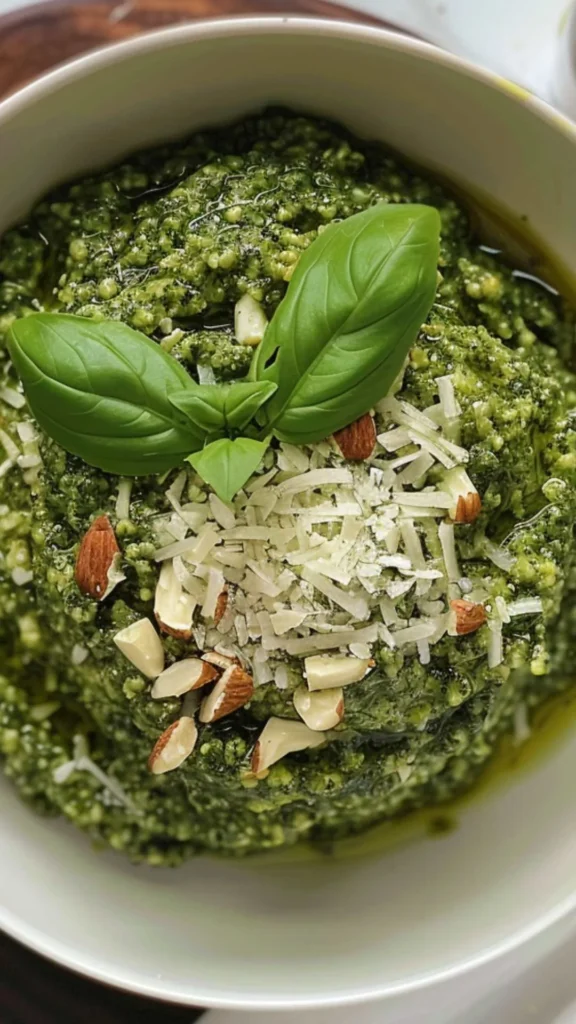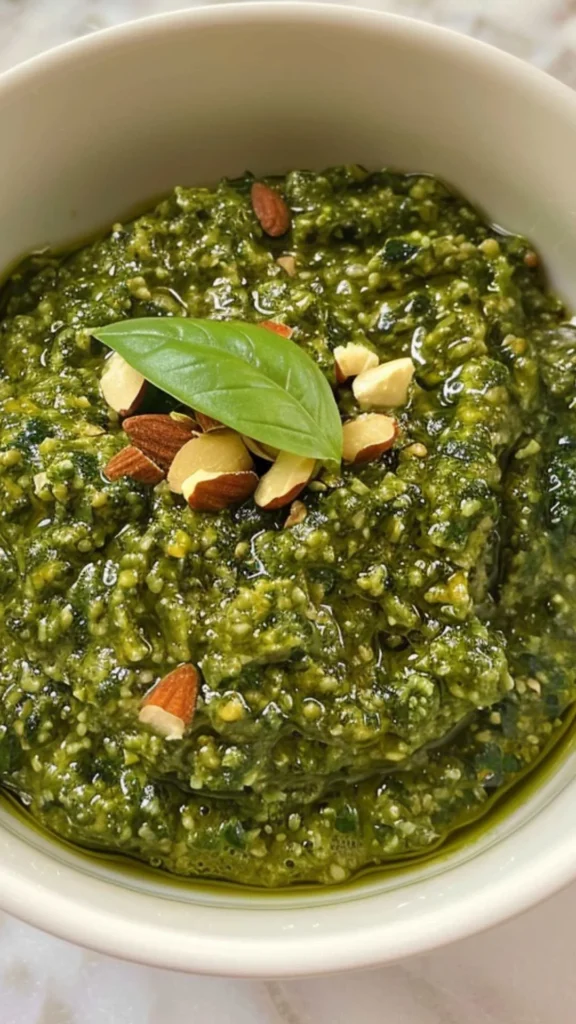Last Updated on February 26, 2024
As I embarked on my culinary journey, I stumbled upon a delightful and unique twist to the traditional pesto recipe – almond pesto. Intrigued by the idea of incorporating the nutty goodness of almonds into this classic Italian sauce, I delved deeper into the world of almond pesto, uncovering its rich history, diverse flavors, and unparalleled versatility.
In this engaging narrative, join me as I unravel the secrets of almond pesto, exploring its essence, preparation, and tantalizing taste that will leave your taste buds craving for more.

What is almond pesto?
Almond pesto is a contemporary rendition of the traditional Italian pesto sauce, where almonds are used as a key ingredient in place of the classic pine nuts. This innovative twist brings a unique flavor profile to the dish, adding a rich nuttiness and subtle crunch that elevate the overall experience.
The combination of fresh basil, roasted almonds, garlic, olive oil, and parmesan cheese creates a luscious and aromatic sauce that is both comforting and invigorating.
What is the flavor profile of this dish?
The flavor profile of almond pesto is a harmonious blend of earthy, nutty, and herbaceous notes that create a symphony of flavors on the palate. The freshness of the basil leaves infuses a vibrant and aromatic quality to the sauce, while the roasted almonds impart a toasty richness and depth.
The garlic adds a pungent kick, complemented by the sharpness of the parmesan cheese, resulting in a savory and indulgent taste. The olive oil ties everything together, lending a silky smooth texture and a hint of fruitiness to the dish.
What Makes This Recipe Different From Other almond pesto?
What sets almond pesto apart from other variations is the distinctively nutty flavor and crunchy texture that the almonds bring to the table. While traditional pesto recipes often call for pine nuts, using almonds adds a unique twist and a delightful crunch that sets this version apart.
The combination of roasted almonds and fresh basil creates a dynamic flavor profile that is both comforting and sophisticated, making almond pesto a standout choice for those seeking a new and exciting pesto experience.

Ingredients You’ll Need:
- Fresh Basil Leaves: Fresh basil leaves are the heart and soul of pesto. They provide a vibrant green color and a fragrant, herbaceous flavor that is quintessential to this sauce. Basil adds a refreshing and aromatic quality that brightens up the dish.
- Roasted Almonds: Roasted almonds add a nutty richness and texture to the pesto. They contribute a subtle crunch and depth of flavor, complementing the fresh basil and enhancing the overall taste profile. Additionally, almonds provide healthy fats and protein, making the pesto more satisfying.
- Extra Virgin Olive Oil: Extra virgin olive oil serves as the primary fat and emulsifier in the pesto. It helps bind the ingredients together and create a smooth, creamy texture. Olive oil also adds richness and a fruity, peppery flavor that enhances the taste of the pesto.
- Grated Parmesan Cheese: Grated Parmesan cheese adds a salty, nutty flavor and a creamy texture to the pesto. It contributes depth and richness to the sauce, complementing the other ingredients and adding complexity to the flavor profile. Parmesan cheese also helps thicken the pesto and enhance its consistency.
- Garlic Cloves: Garlic cloves add pungent, aromatic flavor to the pesto. They provide a sharp contrast to the sweetness of the basil and help balance out the richness of the olive oil and cheese. Garlic adds depth and complexity to the pesto, making it more flavorful and robust.
- Kosher Salt: Kosher salt is used to season the pesto and enhance the flavors of the other ingredients. It helps balance the sweetness of the basil and the richness of the olive oil and cheese. Salt also helps to bring out the natural flavors of the almonds and garlic, ensuring a well-seasoned pesto.
- Ground Black Pepper: Ground black pepper adds a subtle heat and spice to the pesto. It complements the other flavors in the sauce and adds depth to the overall taste profile. Black pepper also helps balance the sweetness of the basil and the richness of the olive oil and cheese.
Step by Step Directions:
Step 1: Organize and Prepare Ingredients
- Begin by arranging all the required ingredients neatly on your kitchen counter or workspace. Make sure you have fresh basil leaves, roasted almonds, extra virgin olive oil, grated parmesan cheese, garlic cloves, kosher salt, and ground black pepper ready for use.
Step 2: Load Ingredients into the Processor
- Take the bowl of your food processor or high-speed blender and add the fresh basil leaves, roasted almonds, extra virgin olive oil, grated parmesan cheese, garlic cloves, kosher salt, and ground black pepper into it.
- Ensure each ingredient is measured accurately and added to the bowl in the correct proportions.
Step 3: Blend to Combine
- Start the food processor or blender and blend the ingredients together until they are thoroughly combined. This process usually takes between 30 seconds to 1 minute and 30 seconds.
- Aim for a texture that suits your preference, whether it’s a coarse mixture or a smoother consistency. You can adjust the blending time accordingly.
Step 4: Check and Adjust Seasoning
- Once blended, pause to taste the almond pesto and assess its seasoning. Add more kosher salt if necessary, ensuring it complements the flavors without overpowering them.
- Take into account the natural saltiness of the parmesan cheese when adjusting the seasoning.
Step 5: Achieve Desired Texture
- If you find that the almond pesto is too thick for your liking, you can adjust its texture by incorporating a small amount of water or extra virgin olive oil.
- Gradually add the liquid while continuing to blend until you reach the desired consistency. This step allows you to tailor the pesto to your preferences.
Step 6: Serve or Store
- Transfer the freshly made almond pesto into a clean jar or airtight container suitable for storing.
- Utilize the almond pesto immediately as a flavorful sauce for pasta, a spread for sandwiches, or a topping for grilled meats and vegetables. Alternatively, refrigerate it for later use, ensuring it’s tightly sealed to maintain freshness.
Tips On Making Almond Pesto
– Toast the almonds for extra flavor: Roasting the almonds enhances their nutty taste and adds a delightful depth to the pesto.
– Use high-quality ingredients: Opt for the freshest basil, extra virgin olive oil, and parmesan cheese to ensure a rich and vibrant flavor profile.
– Adjust seasoning to taste: Feel free to customize the amount of salt and pepper according to your preference, ensuring the pesto is perfectly seasoned.
– Store in an airtight container: To preserve the freshness of the almond pesto, transfer it to a sealed container and refrigerate for up to a week.
– Experiment with variations: Get creative with your almond pesto by adding sun-dried tomatoes, lemon zest, or chili flakes for a unique twist on the classic recipe.

Nutrition Information:
A serving of almond pesto typically contains approximately 160 calories, with 14 grams of fat, 4 grams of carbohydrates, and 5 grams of protein. This nutrient-dense sauce is a good source of healthy fats from the almonds and olive oil, as well as calcium and protein from the parmesan cheese. The fresh basil adds a dose of antioxidants and vitamins, making almond pesto a flavorful and nourishing addition to your meals.
How Can I Store This almond pesto?
To store almond pesto, transfer it to an airtight container and refrigerate for up to a week. Ensure that the pesto is fully covered with a thin layer of olive oil on top to prevent discoloration and maintain freshness.
Alternatively, you can freeze almond pesto in ice cube trays for individual portions that can be easily thawed and used as needed. Just remember to thaw the pesto in the refrigerator before using to preserve its texture and flavor.
If the items are not available in your kitchen, what are some substitute options for the ingredients?
– Fresh basil leaves: Substitute with arugula or spinach for a different flavor profile.
– Roasted almonds: Use pine nuts, walnuts, or cashews for a similar nutty texture.
– Extra virgin olive oil: Replace with avocado oil or sunflower oil for a different richness.
– Grated parmesan cheese: Try pecorino Romano, grana padano, or nutritional yeast for a cheesy umami kick.

Almond Pesto Recipe
Equipment
- Food processor or high-speed blender
- Measuring tools (spoons, cups)
Ingredients
- ⅓ cup grated parmesan cheese
- 2 cloves garlic large
- 2 cups fresh basil leaves only lightly packed – about 1 ½ ounces
- ¼ cup roasted almonds
- ½ teaspoon kosher salt or to taste
- ½ cup extra virgin olive oil
- 1/5 tsp. ground black pepper
Instructions
Step 1: Organize and Prepare Ingredients
- Begin by arranging all the required ingredients neatly on your kitchen counter or workspace. Make sure you have fresh basil leaves, roasted almonds, extra virgin olive oil, grated parmesan cheese, garlic cloves, kosher salt, and ground black pepper ready for use.
Step 2: Load Ingredients into the Processor
- Take the bowl of your food processor or high-speed blender and add the fresh basil leaves, roasted almonds, extra virgin olive oil, grated parmesan cheese, garlic cloves, kosher salt, and ground black pepper into it.
- Ensure each ingredient is measured accurately and added to the bowl in the correct proportions.
Step 3: Blend to Combine
- Start the food processor or blender and blend the ingredients together until they are thoroughly combined. This process usually takes between 30 seconds to 1 minute and 30 seconds.
- Aim for a texture that suits your preference, whether it’s a coarse mixture or a smoother consistency. You can adjust the blending time accordingly.
Step 4: Check and Adjust Seasoning
- Once blended, pause to taste the almond pesto and assess its seasoning. Add more kosher salt if necessary, ensuring it complements the flavors without overpowering them.
- Take into account the natural saltiness of the parmesan cheese when adjusting the seasoning.
Step 5: Achieve Desired Texture
- If you find that the almond pesto is too thick for your liking, you can adjust its texture by incorporating a small amount of water or extra virgin olive oil.
- Gradually add the liquid while continuing to blend until you reach the desired consistency. This step allows you to tailor the pesto to your preferences.
Step 6: Serve or Store
- Transfer the freshly made almond pesto into a clean jar or airtight container suitable for storing.
- Utilize the almond pesto immediately as a flavorful sauce for pasta, a spread for sandwiches, or a topping for grilled meats and vegetables. Alternatively, refrigerate it for later use, ensuring it’s tightly sealed to maintain freshness.
Notes
- – Toast the almonds for extra flavor: Roasting the almonds enhances their nutty taste and adds a delightful depth to the pesto.
- – Use high-quality ingredients: Opt for the freshest basil, extra virgin olive oil, and parmesan cheese to ensure a rich and vibrant flavor profile.
- – Adjust seasoning to taste: Feel free to customize the amount of salt and pepper according to your preference, ensuring the pesto is perfectly seasoned.
- – Store in an airtight container: To preserve the freshness of the almond pesto, transfer it to a sealed container and refrigerate for up to a week.
- – Experiment with variations: Get creative with your almond pesto by adding sun-dried tomatoes, lemon zest, or chili flakes for a unique twist on the classic recipe.
Nutrition
Frequently Asked Questions
Q1. Can I make almond pesto without cheese for a vegan version?
– Yes, you can omit the parmesan cheese and add nutritional yeast or vegan cheese as a substitute for a dairy-free and vegan-friendly almond pesto.
Q2. Is almond pesto suitable for people with nut allergies?
– If you have a nut allergy, you can try making pesto with seeds such as pumpkin seeds or sunflower seeds instead of almonds for a nut-free version that retains the essence of the dish.
Q3. Can I use almond meal instead of whole almonds in almond pesto?
– While almond meal can be used as a substitute for whole almonds, the texture and flavor may vary slightly. Adjust the amount of almond meal to achieve the desired consistency in the pesto.
Q4. How long does almond pesto last in the refrigerator?
– Almond pesto can be stored in the refrigerator for up to a week if properly sealed and covered with a layer of olive oil. Be sure to check for any signs of spoilage before consuming.
Q5. Can I use almond pesto as a marinade for meats and vegetables?
– Yes, almond pesto can be used as a flavorful marinade for a variety of proteins such as chicken, fish, or tofu, as well as roasted vegetables for a tasty and aromatic twist to your dishes.
Conclusion:
In this culinary exploration of almond pesto, we have uncovered a world of flavor, texture, and creativity that transcends traditional boundaries. The fusion of fresh basil, roasted almonds, garlic, olive oil, and parmesan cheese in this innovative sauce offers a delightful and versatile twist on the classic pesto recipe.
Whether enjoyed tossed with pasta, drizzled over grilled vegetables, or used as a marinade for meats, almond pesto is a culinary gem that promises to elevate your dishes to new heights.
As you embark on your own almond pesto journey, remember to savor the nutty richness, the herbal freshness, and the indulgent creaminess that this sauce has to offer. Experiment with different ingredients, adjust the seasonings to your taste, and let your creativity run wild in the kitchen.
With its vibrant flavors and nutritional benefits, almond pesto is not just a sauce but a culinary companion that will inspire and delight your senses with each bite. So go ahead, whip up a batch of almond pesto, and experience the magic of this modern twist on a timeless classic.



